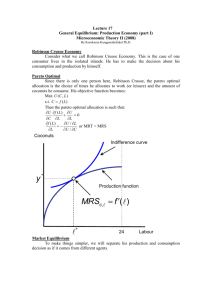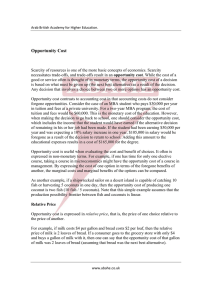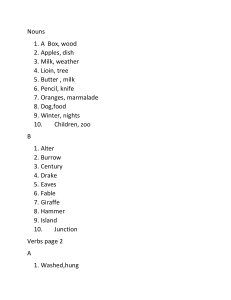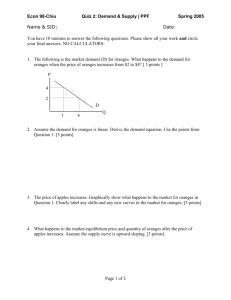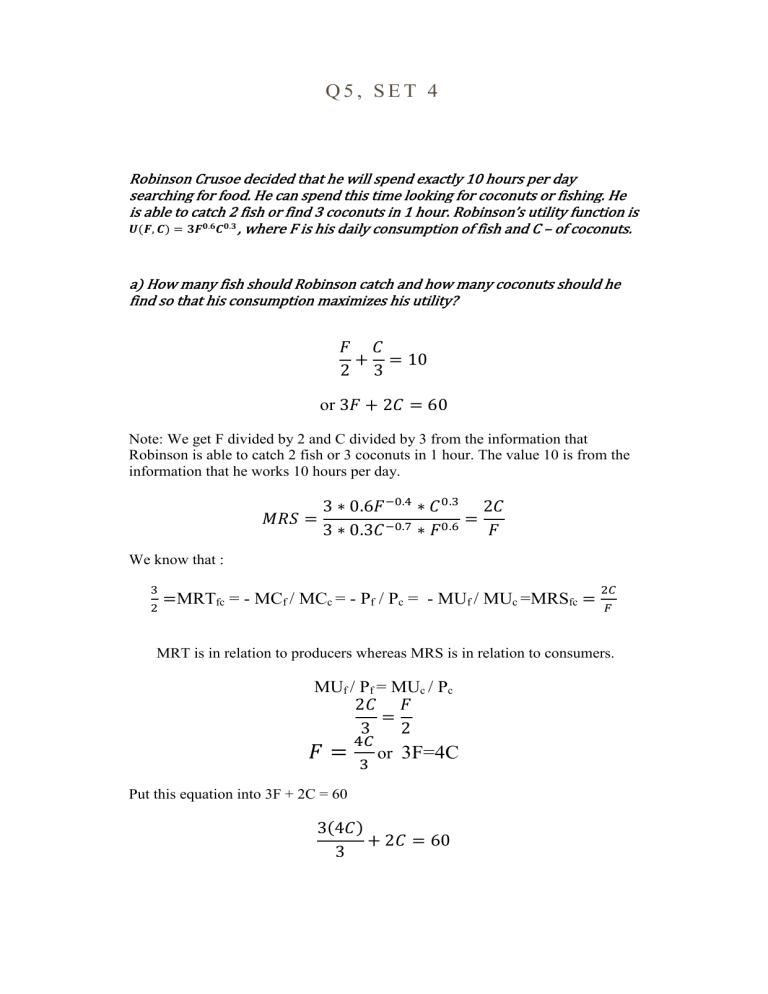
Q5, SET 4 Robinson Crusoe decided that he will spend exactly 10 hours per day searching for food. He can spend this time looking for coconuts or fishing. He is able to catch 2 fish or find 3 coconuts in 1 hour. Robinson’s utility function is !(#, %) = (#).* %).( , where F is his daily consumption of fish and C – of coconuts. a) How many fish should Robinson catch and how many coconuts should he find so that his consumption maximizes his utility? / 1 + = 10 2 3 or 3/ + 21 = 60 Note: We get F divided by 2 and C divided by 3 from the information that Robinson is able to catch 2 fish or 3 coconuts in 1 hour. The value 10 is from the information that he works 10 hours per day. 3 ∗ 0.6/ 78.9 ∗ 1 8.: 21 345 = = 3 ∗ 0.31 78.; ∗ / 8.< / We know that : : = =MRTfc = - MCf / MCc = - Pf / Pc = - MUf / MUc =MRSfc = => ? MRT is in relation to producers whereas MRS is in relation to consumers. MUf / Pf = MUc / Pc 21 / = 3 2 /= 9> : or 3F=4C Put this equation into 3F + 2C = 60 3(41) + 21 = 60 3 1 = 10 /= 4 ∗ 10 = 13.3 3 From the calculations above we get 40/3 Fish and 10 Coconuts ⇒ U = 3F0.6C0.3 = 28.3 b) Illustrate the equilibrium with a graph. C 30 10 F 40 3 20 One day a native inhabitant of another island arrives on Robinson’s island. The visitor offers Robinson trade of 3 fish for 1 coconut. However, trade is not free, it costs 1 fish (that must be paid prior to the exchange). c) Will Robinson decide to trade? Justify your answer and provide a graph. Since Robinson has comparative advantage in C, he will specialize in coconuts ⇒ maxC = 10*3 =30 However, if he wish to trade with native inhabitant, he has to pay 1F before the trade ⇒ he cannot spent all his time just on picking coconuts, but he has to catch at least one fish ⇒ he will spend 0.5h on F and 9.5h on C ⇒ maxC = 0.5*1 + 9.5*3 =28.5, where 3 is his productivity in C. but he cannot pick 0.5C ⇒ maxC=28 If Robinson catch only fish, his maxF=10*2-1=19, i.e. 1is the transaction cost and 2 is his productivity in F. However, he may have more F through the trade rather than catch them directly ⇒ If he picks coconuts and exchange them for fish, the maxF=28*3=84, i.e. 3 is the exchange rate His new PPF is the following: / + 31 = 84 where (F+3C) describes the exchange rate with native inhabitant, while 84 is maxF In other words, / 1 + = 9.5 9 3 > here : means his productivity 3C per hour since he will specialize in coconuts, ? Q means his exchange rate 3C*3 since he will buy F, and 9.5=10- 0.5 means the time he may spend on picking coconuts since 0.5h he has to spent on fishing in order to cover transaction cost. S : (the previous was MRT= ) His new MRT= : = MRS=MRT 21 1 = 3 / # = *% ⇓ 61 0 31 = 84 C*=84/9=9.3 F*=56 coconut 30 28 9,3 20 56 84 fish New utility U = 3F0.6C0.3 = 65.6 is higher than the old one ⇒ Robinson will choose to trade. d) What will Robinson produce? Due to comparative advantage he will produce coconuts. e) What will Robinson consume? His preferences (Cobb-Douglas) enforce him to consume both goods. As in graph and calculations above he will consume 56 units of fish and 9.3 coconuts
